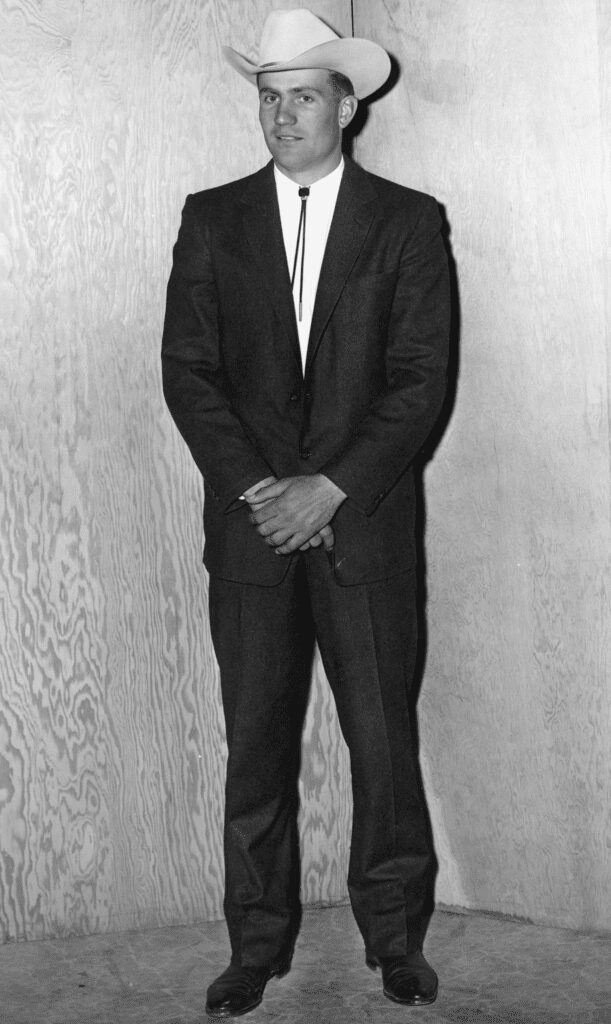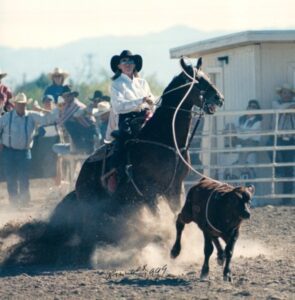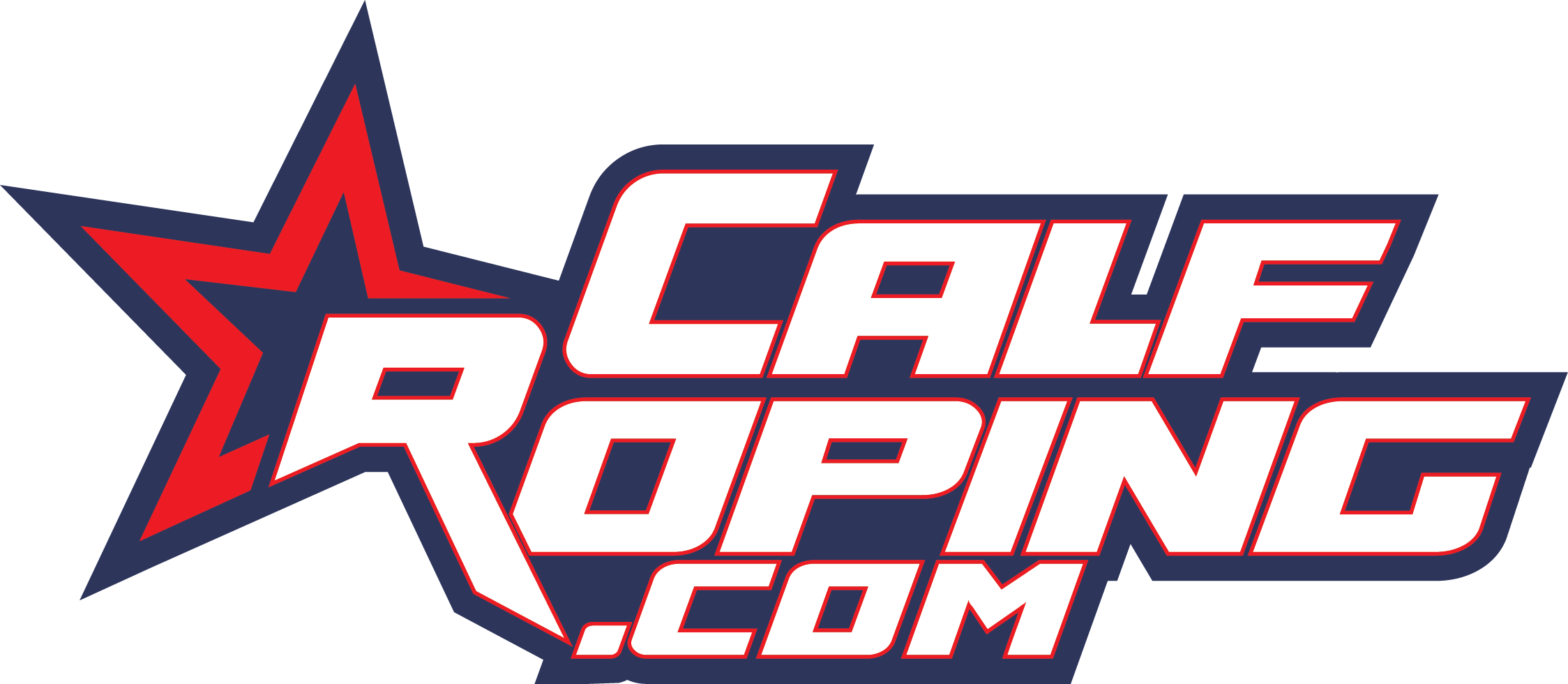Calf roping as sport began in the late 1800’s in the United States, growing from true cowboy skills often needed on the ranch. Cowboys alone on the range, needing to secure a calf for branding, doctoring or even for transportation, had to master catching and tying calves without a helper other than their horses. Tremendous skill was required to catch a calf in the pasture, on the plains, with no fences to help limit the area into which he could escape.
Rodeo in general in its earliest days primarily grew from these ranching practices and the habits of cowboys to match their work skills against others for sport and gambling. Sometimes held at the end of long cattle drives, early rodeos almost always included bucking horse contests and roping was featured too, both calf roping and single steer roping.
As the need for cattle drives waned around the turn of the century, cowboys with less work available migrated into competition and exhibitions as a means of generating personal revenue. While the site of the first organized rodeo is in debate with Deer Trail, Colorado, Prescott, Arizona and Pecos, Texas, among others, all laying claim to the title, there is no doubt that rodeos grew in size and purse as the 20th century dawned.
Organizing and Naming World Champions
While many of the biggest rodeos of the early 1900’s like the Pendleton Round-Up, Madison Square Garden and Cheyenne Frontier Days, all called their winners, “World Champions,” it wasn’t until 1929 that attempts to organize for year long titles began. That year, the Rodeo Association of American (RAA) was formed primarily by rodeo producers to try to bring structure to the various rodeo events across the nation.
Later, in 1939, the Cowboy Turtles Association (CTA) was born, spurred on by the contestants’ boycott of the Madison Square Garden rodeo over unfair practices. The CTA later evolved into the Rodeo Cowboys Association (RCA) and today’s Professional Rodeo Cowboys Association (PRCA).
Everett Bowman of Hillside, Arizona is credited with winning the first World Championship in calf roping back in 1929 under the original RAA. He won again in 1935 and 1937, the first cowboy to win more than one title.
Ladies have been tying calves down for years too and calf roping was one of the earliest events sanctioned by the brand new Girls Rodeo Association (GRA), which was founded in San Angelo in 1948. The legendary Betty Dusek won the first GRA World Championship in Calf Roping that year.
The GRA’s name was changed to the Women’s Professional Rodeo Association (WPRA) back in 1981. The WPRA still crowns a world champion in what’s now known as tie down roping each year.
Calf Roping Dynasties
Calf roping was part of every major rodeo association from its outset. The National Intercollegiate Rodeo Association (NIRA) offered only the three rough stock events, wild cow milking, steer wrestling and calf roping in its inaugural finals in 1949. Eldon Dudley won that contest over second ranked Tuffy Cooper. Cooper would return in 1950 to take the title.
The Cooper name appears throughout the history of calf roping. Tuffy’s son Roy won eight PRCA World titles including six in the calf roping and is often credited with revolutionizing the sport during his run in the 1970’s and 1980’s; his daughter, Betty Gayle, was a WPRA World Champion calf roper three times and earned All Around, breakaway and goat tying titles too.
Tuffy’s grandsons Clint, Clif and Tuf Cooper made history when all three brothers qualified and competed at the Wrangler National Finals Rodeo (NFR) in 2010-2011, the only three-brother sets to do so in the calf roping. Tuf has earned four World Championships including three in calf roping.
Another calf roping dynasty is the Sewalt family. Patriarch Royce won a tie down world title in 1946; son Ronnye, a rare left handed roper, followed him into the sport and qualified for 16 NFR’s from 1961 to 1978, a record at the time. Ronnye’s son Rusty competed at the sport’s championship event five times in the 1990’s.
Innovations in Calf Roping
The Start. Even up until the 1960’s, calf roping could begin from the left or right side of the chutes and big rodeos like Salinas and Calgary only used the box on the left, the “heading” side in today’s language. Today, Salinas has held onto that tradition and Pendleton allows ropers to choose their side, but it’s pretty universal everywhere else to have the roper leave from the calf’s right side.
Flanking. In the beginning, many ropers “legged” calves down—picking up the calf’s right front leg and pushing it up and towards his tail to force him to the ground instead of flanking as is the practice today. The roper would then step across the calf to begin his tie.
By the mid-1960’s, flanking had become more popular because it was considered faster. Glen Franklin is often credited with created a faster, smoother flank during that era. Franklin simply rolled the calf over his knees instead of lifting cattle into the air as his contemporaries did. During the 1965 NFR, Franklin used this technique to tie a 300-pound Brangus down in 10.6 seconds, the fastest calf tied that year by more than half a second to help clinch his first PRCA World title.
Dismounting to the Right. With the move toward flanking instead of legging, ropers needed to be on the calf’s left side to complete the move. At first, most ropers simply dismounted from the left side of their horse and stepped under the rope.
Roy “Super Looper” Cooper was not the first calf roper to dismount his horse from the right side but he most certainly was the first to do it with the speed, smoothness and consistency that is commonplace now.
One of the sport’s most credited innovators, Cooper also tied faster than most of his contemporaries, using a different method known as the short wrap.
Handling the Slack. As calf size has diminished in competitive roping over the years and fines for jerk downs have been instituted, the ability to handle the slack after roping the calf has become imperative. In the 1950s and 1960s, ropers often pitched their slack into the air on 350-400 pound calves. Today, ropers keep the slack in their hand as they dismount, ultimately hoping to simply switch the calf around and leave him on his feet for quick flanking.
Down The Rope. In past times, ropers actually wanted to stay in the stirrup until the calf hit the end of the rope as an aid to their horses. Today, in connection with other changes like handling the slack and smaller, more conditioned calves, ropers hold their slack, allowing it to pull them from the stirrup just ahead of the calf hitting the end, shaving precious tenths off their times.
Ropes. Technology has improved nearly every tool in a cowboy’s arsenal, from what he feeds his horse to how his saddle is made. Ropes have benefitted from such advancements as well, from grass ropes that were prone to breaking, such as the two that broke in back to back rounds to close the 1965 NFR, costing Dean Oliver his record breaking eighth world championship that year (he later got it in 1969), to blends of synthetic materials that don’t break and resist changes from weather conditions.

New Name, Same Skill Set
In 2006 the PRCA announced that calf roping would henceforth be known as “tie down” roping. The name change was strange to some at first but seems to have found its place in history and most rodeo associations have followed suit.
Returning to Their Roots: Jackpots and Match Ropings
Today, there is plenty of money to be made outside of the rodeo arenas of the various professional and regional associations. Perhaps the most famous of these is the CINCH Roping Fiesta, produced by the San Angelo Stock Show & Rodeo every year since 1954. The Roping Fiesta made calf roping a staple of its production beginning in 1962 and has included a match roping along with the traditional jackpot ever since.
Tom Nesmith won the first Roping Fiesta in 1962; Cody Ohl is the most decorated calf roper at the Fiesta, winning the match roping 15 times.
In addition to the stand-alone jackpot events, there are also many associations now dedicated solely to calf roping, including the Ultimate Calf Roping (UCR) which offers a level playing field by assigning numbers to ropers based upon their skill level and experience.
National Finals Rodeo and Records
-The NFR was created in 1959 and Del Rio, Texas cowboy Jim Bob Altizer was the first then-RCA member to earn a calf roping world title through the new season ending championship event. Dean Oliver of Boise, Idaho won it the next year, his second of a record eight championships that has yet been unmatched.
-When the NFR landed in Oklahoma City in 1966, Junior Garrison laid claim to the title; when the “SuperBowl of Rodeo” went to Las Vegas in 1985, rookie Joe Beaver was the first to earn a calf roping championship in the City of Lights.
-Beaver shares the record for most average titles won at the NFR with four. The other ropers to win four averages are: Olin Young, Roy Cooper, and Fred Whitfield.
-Six-time World Champion Cody Ohl holds the record for go round wins in the tie down roping at the NFR with 52; he also shares the NFR round record of 6.5 seconds with Trevor Brazile. Ohl has won $1.4 million at the NFR alone in his career.
-Ohl shares the record for most NFR go rounds won in a single year with five, a feat he has accomplished twice. 1978 World Champion Dave Brock is the only other calf roper to do so.
-Mike Johnson holds the record for most NFR qualifications at 23.
-Shane Hanchey set the NFR record for the average en route to his World Championship in 2013 when he roped and tied ten head in 80.1 seconds.

Jolee Jordan
Jolee Jordan served as the Women’s Professional Rodeo Association Roping Director for over 25 years. Jordan is also a previous NFR qualifier in the barrel racing and has long since established herself as one of the top journalists in the western industry. Jordan has been a long-time contributor to The Team Roping Journal Magazine and brings her unique perspective to CalfRoping.com




